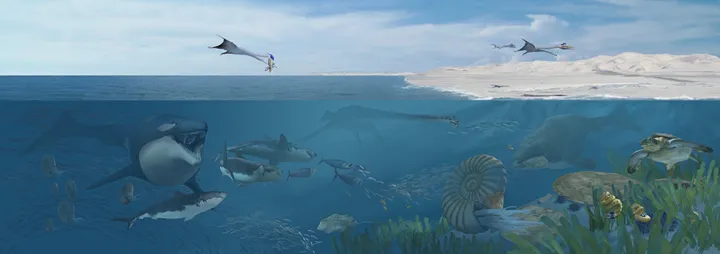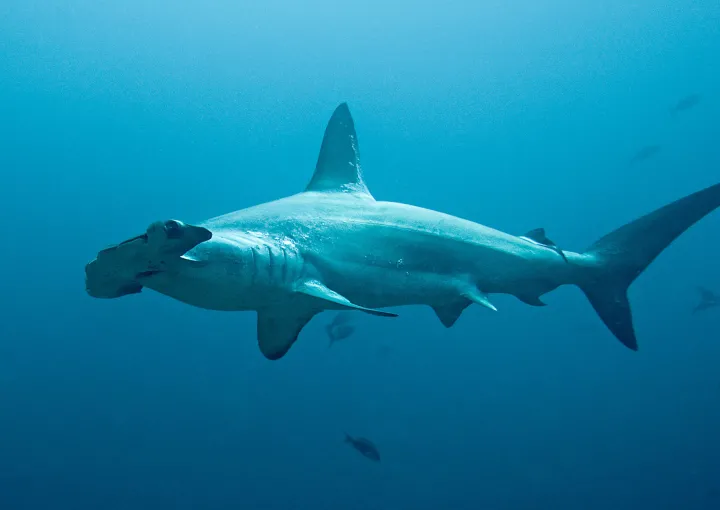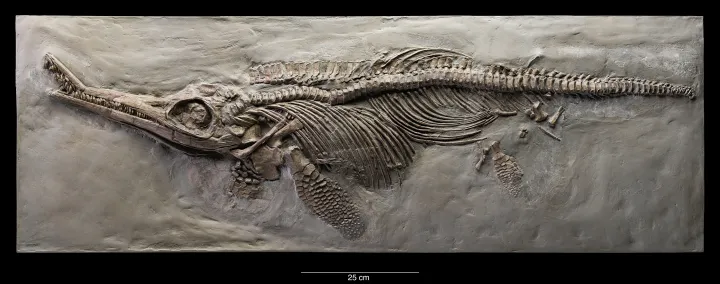Form Equals Function for Ancient Sea Lizards and Modern Whales

In the ocean there once lived a creature built for predatory prowess. It had teeth shaped to a point for snagging prey, a tail fluke shaped like a crescent moon for propelling it through the water, and skin coloration that made it nearly invisible to unsuspecting prey. Although it may seem like a no-brainer that this creature was an ancestor of today’s whales or sharks, in reality, it was a sea-dwelling lizard called a mosasaur.
The world of ancient seas may seem foreign and impossible to imagine, but in reality, many of the creatures that roamed the ocean during the age of dinosaurs looked very similar to those we know today—even though many are only distantly related. How is this the case? Evolution has many tricks up its sleeves, one of which is convergent evolution, where the body parts of unrelated species adapt to solve similar problems, such as the wings of bats and birds. This phenomenon centers around the fact that environments play a role in shaping the species that live there. Sharks and dolphins provide an excellent example. Though sharks are fish and dolphins are mammals, both have streamlined bodies with flippers, flukes and dorsal fins on their back. This is not proof of their relatedness, but rather that this body shape is ideal for their particular life at sea.
During the Triassic, Jurassic, and Cretaceous periods, when dinosaurs reigned on land, sea reptiles lived in the ocean. Like the dolphins and sharks of today, they were efficient swimmers and consumers. The ichthyosaur had a protruding bill filled with teeth that allowed for quick jabs at fish. The plesiosaur swam with four paddle-like flippers, unlike anything that exists in today’s seas. And some mosasaurs had powerful bodies reminiscent of an orca.
The most striking similarity between today’s top predators and the top predators of ancient seas is the tail fluke. Time and time again creatures have evolved a crescent moon shaped tail. Not only is this visible in whales, dolphins, and sharks, it is also the case for mosasaurs and ichthyosaurs. And yet scientists know that despite this universal shape, each lineage evolved the crescent moon tail independently. Marine reptiles, like sharks, beat their tales from side to side while whales and dolphins beat their tales up and down.
When first discovered in the early 1800s, scientists thought all ichthyosaurs had a straight, eel-like tail. Indeed, many of the early ichthyosaurs had a primitive, elongate tail, but as ichthyosaurs evolved to be more efficient swimmers their tails were integral to that transition. It wasn’t until the 1890s that a well-preserved skeleton of a more evolved ichthyosaur was found with a proper outline of its body. Bacteria had eaten away at the decomposing body, leaving behind a shadow of the lizard’s shape in the surrounding rock—this revealed a dorsal fin and a crescent moon tail. The skeleton kinked downward at the end and the top half was built completely of flesh. Further examination of the tail vertebrae revealed that, indeed, the bones at the end of the tail were built to support the structure of a fleshy tail.
But it wasn’t until the last couple of decades that scientists began examining the shape of mosasaur vertebrae with the intention of determining whether this marine lizard also had a crescent fluke. Upon studying a number of mosasaurs scientists again saw a series of specially shaped vertebrae that indicated a bend in the tail and changes in the spines that showed it supported a fleshy fluke on top. Then in 2013, scientists found their confirmation. A newly discovered mosasaur fossil was found with the outline of a crescent tail clearly visible. Marine lizards, it turns out, evolved a crescent-shaped tail.
But body shape isn’t the only trait sea lizards and top predators of today have in common. In today’s world lizards are ectotherms, meaning that their body temperature conforms to the temperature of their surroundings. A hot rock on a sunny day is a great place for lizards and other reptiles to warm their body, just like a dip in the water will cool it back down. Mammals, on the other hand, are endotherms—they regulate their body temperature themselves. Recently, scientists discovered that some lizards were able to do this to some extent too, at certain points in time.
To understand ancient sea lizard metabolism, scientists turned to clues hidden in the teeth of ichthyosaurs, plesiosaurs, and mosasaurs. Teeth are built of phosphate, a molecule that is made up of phosphorous and oxygen. Not all oxygen is the same, a fact that scientists exploit to their advantage. Some atoms of oxygen contain eight neutrons to pair with the eight protons in the core of the atom—Oxygen 16. But there is another naturally occurring and stable form of oxygen that has extra neutrons, called Oxygen 18 and the extra neutrons make it heavier than Oxygen 16. The relationship between Oxygen 16 and Oxygen 18 is directly related to the temperature of the environment, in this case, the body of the sea lizard. Scientists are also able to use this method on fish skeletons—as ectotherms, fish bodies are the same temperature as the water. By comparing the sea lizard teeth to the fish skeletons, the scientists were able to determine if the sea lizards had the same body temperature as the surrounding water.
They did not.
Both ichthyosaurs and plesiosaurs were found to have a body temperature similar to that of today’s whales, between 95 to 102 degrees Fahrenheit (35-39 degrees Celsius). Mosasaurs, though they had an elevated body temperature compared to the sea temperature, were found to be influenced by the water. When the surrounding water temperature dipped or spiked, so did the temperature of the mosasaur’s body. Some shark species also regulate their body in such a way. Scientists believe both the ancient reptiles and the sharks evolved in such a way to help meet the demands of being a powerful predator, for traveling long distances or for quick bursts of speed.
Evolution can act in what seems like mysterious ways, shaping unrelated creatures to appear and operate in similar manners despite living millions of years apart. So, as you envision massive sea lizards roaming ancient seas, just think about the creatures of today—you may be surprised by how close your vision is to reality.




